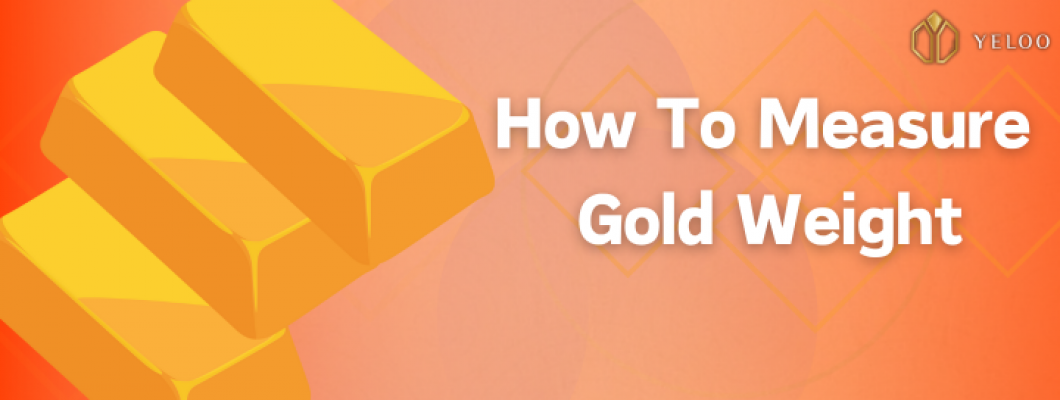How To Measure Gold Weight

How to Measure Gold Weight Accurately for Jewellery Purchases and Sales
Gold is one of the most valuable materials in the world, revered for its beauty, rarity, and cultural significance. In the world of jewellery, gold holds an even more special place, representing wealth, tradition, and personal style. When buying or selling gold jewellery, one key factor determines its worth—gold weight. Accurately measuring gold weight is essential to both buyers and sellers, as it directly impacts pricing, authenticity, and trust in the transaction.
In this blog post, we will guide you through the importance of gold weight, methods to measure it accurately, and practical tips for ensuring trustworthy gold jewellery purchases and sales. Whether you're a buyer wanting to make an informed decision or a seller ensuring transparency, understanding how to measure gold weight is crucial.
Why Gold Weight Matters
Determining the Value of Jewellery
The value of gold jewellery primarily depends on the weight of the gold it contains. In addition to the design and craftsmanship, the amount of pure gold in a piece directly affects its price. Gold is typically measured in grams, ounces, or other specialized units (such as troy ounces), and its market price fluctuates based on supply, demand, and global economic factors.
Pricing and Purchasing Decisions
When purchasing gold jewellery, the weight determines a large portion of the price tag. For sellers, accurately measuring gold weight is crucial to avoid underpricing or overpricing items. For buyers, verifying the weight ensures they are paying a fair price for the amount of gold in the jewellery. It’s important to understand that higher weight means more gold content, but this is influenced by other factors such as design elements, craftsmanship, and gemstone additions.
Units of Measurement
Common Units for Gold Weight
There are several units of measurement used for gold, depending on the region and the type of transaction:
- Grams (g): The most commonly used unit for gold jewellery worldwide. It's a metric unit and is widely understood in the jewellery industry.
- Ounces (oz): In the U.S. and other countries, ounces are used, but it's important to note that regular ounces (avoirdupois ounces) and troy ounces are different.
- Troy Ounces (t oz): The troy ounce is a traditional unit specifically for measuring precious metals, including gold. One troy ounce is approximately 31.1035 grams, slightly heavier than the standard ounce.
Regional Variations in Measurement
Different countries may use varying units to measure gold, depending on local customs and practices. In Europe and many parts of Asia, grams are the standard. In the U.S., both ounces and grams are used, with the troy ounce being the most common for bullion and larger gold pieces. When measuring gold jewellery, it’s essential to confirm the unit of weight, especially when dealing internationally, to avoid confusion and ensure accurate pricing.
Methods of Measuring Gold Weight
Traditional Methods: Scales and Balances
For centuries, traditional scales and balances have been used to measure the weight of gold. These mechanical tools rely on counterweights and balance points to give an accurate reading. While reliable, they require careful calibration and consistent use to ensure accuracy.
Modern Methods: Digital Scales and Advanced Tools
Today, digital scales are the go-to method for measuring gold weight, offering precision, convenience, and reliability. Digital scales designed specifically for precious metals can measure gold in grams, ounces, and other units, often to a high degree of accuracy.
How to Measure Gold Weight Accurately at Home
- Choose a Digital Scale: Make sure you’re using a scale designed for small, precise measurements, such as a jewellery or kitchen scale.
- Calibrate the Scale: Ensure your scale is properly calibrated. Most digital scales will have a calibration mode. Follow the instructions in the manual to calibrate the scale using a known weight.
- Use a Clean Surface: Place the scale on a flat, stable surface to ensure accuracy.
- Weigh the Jewellery: Place your gold jewellery on the scale and record the weight. Ensure no other items (such as a container or cloth) are being weighed unless you subtract their weight using the tare function.
- Convert Units if Needed: If your scale shows the weight in a different unit (like ounces), use an online conversion tool or the scale's built-in function to convert to grams or troy ounces as required.
Factors Affecting Gold Weight Measurement
Purity of Gold (Karats)
The weight of gold jewellery is affected by its purity. Gold is often alloyed with other metals to enhance its strength and durability. The purity of gold is measured in karats, with 24 karats representing pure gold. Here’s how purity impacts weight:
- 24k Gold (Pure Gold): 100% gold content. Rarely used for jewellery due to its softness.
- 22k Gold: Contains 91.67% gold, with the remainder made up of other metals.
- 18k Gold: 75% gold and 25% alloy, a common choice for jewellery due to its durability and rich color.
Influence of Gemstones and Other Materials
Jewellery often includes gemstones, enameling, or other materials that add weight but do not contribute to the gold content. These elements can make the jewellery appear heavier, but the value will still primarily be based on the gold’s weight. For accurate gold weight measurement, it’s important to subtract the weight of non-gold elements. Professional jewellers often use specialized tools to separate the gemstone weight from the overall piece.
Accounting for Non-Gold Elements
When buying or selling gold jewellery with added materials (like diamonds, gemstones, or enamel), ask for a breakdown of the gold weight versus the total weight. A reputable jeweller will provide this information so you can understand how much of the piece’s weight is attributed to the gold.
Practical Tips for Buyers and Sellers
For Buyers
- Ask for Weight Verification: Before purchasing gold jewellery, ask the seller to verify the weight using a digital scale. Ensure the weight corresponds with the listed price.
- Understand the Purity: Check the gold’s karat purity. The higher the karat, the more valuable the piece due to its higher gold content.
- Factor in Non-Gold Materials: If the piece includes gemstones, ask how much the gold weighs without these additions to avoid overpaying for non-gold elements.
For Sellers
- Ensure Accurate Measurements: Regularly calibrate your scales to ensure accurate measurements. This builds trust with customers.
- Provide a Weight Breakdown: Offer clear information about the weight of the gold in jewellery pieces, especially if they contain gemstones or other materials.
- Avoid Common Mistakes: Don’t rely on old or uncalibrated scales, and always subtract the weight of containers or packaging when measuring gold.
Conclusion
Understanding how to measure gold weight accurately is essential for both buyers and sellers of gold jewellery. The weight of gold determines its value and price, so ensuring precise measurements builds trust and prevents discrepancies. Whether you're measuring at home or purchasing from a jeweller, following these tips can help you make informed decisions. At Yeloo Jewellery Online Shop, we prioritize transparency and accuracy, providing detailed weight information for all our gold jewellery pieces. Shop with confidence and explore our range of beautifully crafted, high-quality gold jewellery today!
